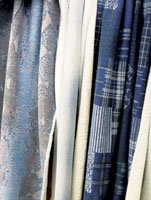Busy L.A. Textile Show Includes Expanded Offerings
The Los Angeles International Textile Show lived up to its name with a broad mix of international exhibitors showing during the show’s March 26–28 run at the California Market Center.
In addition to the European Pavilion and an expanded Korean Pavilion with 18 exhibitors, the show featured domestic resources for fiber, fabric and manufacturing.
The show was decidedly busier than in years past, particularly on the second day of the show, when designers and fabric buyers crowded the aisles.
“You know it’s busy when you have to call a sales rep to come in [to help],” said Pat Tabassi of Los Angeles–based mill Design Knits, which was showing in one of the showrooms on the 13th-floor penthouse pavilion. “I opened the door 10 minutes early this morning, and two people were already there.”
Design Knits was part of the Lenzing Innovation Pavilion, which featured 19 companies, including Buhler Quality Yarns and Asher Fabric Concepts.
Ramin Dashgar of Los Angeles–based importer Cinergy Textiles said he was pleased with the turnout, which included Northern California and out-of-state buyers “that we only see during the shows.”
“When business is good, they travel. They’re looking for new fabrics,” he said.
Raphael Javaheri, chief executive officer of Los Angeles–based Ecotex, noted an upbeat mood at the show.
“The mood is more optimistic than it has been in the last couple of years,” he said. “[Although,] even in a bad economy, if you have the right product at the right price, you can make a killing. It’s all about inventory management and pricing.”
Javaheri said the turnout ranged from students and “mom-and-pop” manufacturers to large Los Angeles brands, including American Apparel, 7 For All Mankind and 3Dots.
Ecotex carries knits and wovens in a range of fabrications, including Tencel. In recent years, the company has been stepping up its international sourcing from Peru, Turkey, China, Korea, Taiwan and Japan. Ecotex is also offering some package production on certain items, such as contemporary knits made in Los Angeles and in Peru and better wovens made in China, Javaheri said.
Among the first-time exhibitors was GPI, a Torrance, Calif.–based manufacturer that exports “more than 90 percent to Japan,” according to Hide Hurase, manager of the nearly 24-year-old company, a division of Topwin Corp. The company produces knits and wovens that can be delivered in four to six weeks.
Another first-time exhibitor was El Monte, Calif.–based sweater and cut-and-sew knits maker Andari.
Ilona Wang, Andari’s marketing director, said the company has attended the show in the past to look for new resources, but it decided to exhibit at the textile show to try to meet more local clients. “We’ve been pretty busy yesterday and today,” he said. “A lot of people didn’t know they could do sweaters in the U.S.”
Although not everyone was prepared to meet Andari’s minimum—300 per style for sweaters and 150 for cut-and-sew knits—Wang said there was potential for the future.
“[They] are not quite there yet, but we expect them to grow, and maybe in the future they’ll come back.”
Brazilian swim textile maker Rosset decided at the last minute to attend the show for the first time, said representative Renata Tolentino.
“We are really happy with the show,” she said. Founded in 1945, Rosset supplies all the “major swim lines” in Brazil, Tolentino said. “We need to come here to have a better market in California.”
Returning exhibitor Fessler USA was also pleased with the show.
Brian Meck, Fessler’s vice president of sales and marketing,described traffic on the second day of the show as “consistently busy.”
“It was quality traffic—good retailers and people who came back multiple times,” he said.
Peter Shen, president and chief executive officer of Los Angeles–based product-development house Phashen Inc., was at the show looking to confirm the trends—“so I don’t repeat myself,” he said.
Shen visits Asia at least five times a year to check on production at several factories for his clients, which include Guess, Bebe and Tilly’s.
“I am helping retailers update their bestsellers,” he said. “I brought the quick-turn mentality to the retailers—and they love it.”
Phashen operates a sample room in Los Angeles and can ship production in 60 days. “I don’t have to shop around; I know what prices are,” Shen said.
Trend watch
Among the items selling well for Ecotex were paper-printed twills. Also, Javaheri said, “We’re doing really well with anything neon.”
Long Beach, Calif.–based knit mill Texollini brought several new developments to the show, said design director Nori Hill.
There were neons mixed with heathers in striped patterns, a burnout fabric made to look like eyelet, linen blends, a pleated fabric made with heat-transfer printing, and blends with Outlast, a nano-technology fiber that responds to body temperature to cool or warm the body.
The company also introduced Texollini Indigo, a collection of top- and bottom-weight indigo knits imported from China. Hill created a display with examples of Texollini Indigo after it has been printed and washed.
At Fessler, many were asking for Supima and Tencel fabrications, Meck said.
Eric Martin, co-designer of Los Angeles–based MartinMartin, was at the show looking for high-end cotton lace, waxed linens and quality leather. “And I always come here for Euromaglia’s knits.”
“Even though a lot [of the reps are] based in L.A., it’s nice to have them all in one place. You can find anything from a high-end rivet to couture lace.”
























